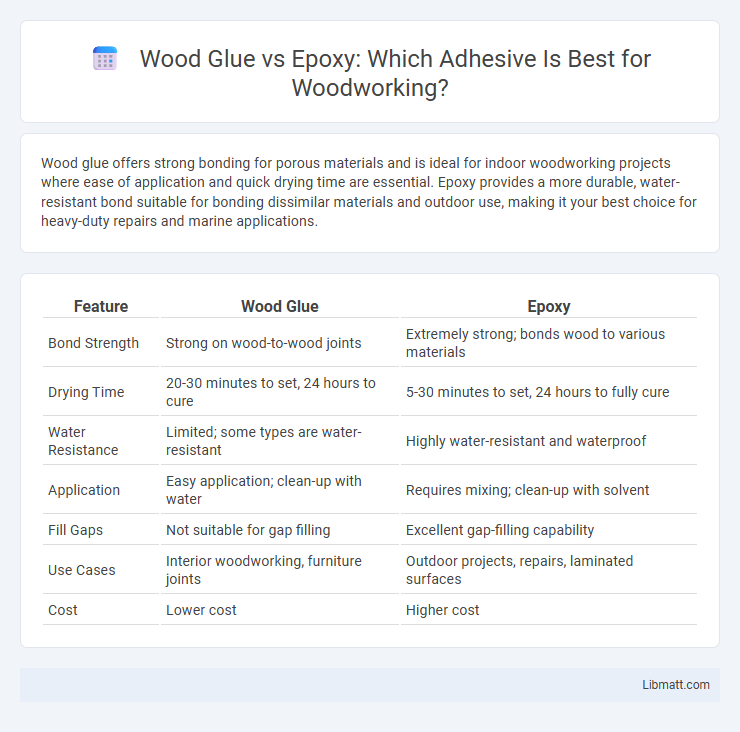Wood glue offers strong bonding for porous materials and is ideal for indoor woodworking projects where ease of application and quick drying time are essential. Epoxy provides a more durable, water-resistant bond suitable for bonding dissimilar materials and outdoor use, making it your best choice for heavy-duty repairs and marine applications.
Table of Comparison
| Feature | Wood Glue | Epoxy |
|---|---|---|
| Bond Strength | Strong on wood-to-wood joints | Extremely strong; bonds wood to various materials |
| Drying Time | 20-30 minutes to set, 24 hours to cure | 5-30 minutes to set, 24 hours to fully cure |
| Water Resistance | Limited; some types are water-resistant | Highly water-resistant and waterproof |
| Application | Easy application; clean-up with water | Requires mixing; clean-up with solvent |
| Fill Gaps | Not suitable for gap filling | Excellent gap-filling capability |
| Use Cases | Interior woodworking, furniture joints | Outdoor projects, repairs, laminated surfaces |
| Cost | Lower cost | Higher cost |
Understanding Wood Glue: Composition and Uses
Wood glue, primarily composed of polyvinyl acetate (PVA) or aliphatic resin, offers excellent adhesion for porous surfaces like wood by penetrating fibers and creating a strong bond. It remains flexible when dry, making it ideal for woodworking projects such as furniture assembly, cabinetry, and carpentry where wood will expand and contract. Your choice of wood glue ensures a reliable join that withstands moisture and stress in typical indoor conditions.
What Is Epoxy? Properties and Applications
Epoxy is a versatile thermosetting polymer known for its exceptional adhesive strength, chemical resistance, and durability, making it ideal for bonding a wide range of materials including wood, metal, and plastic. Its properties include high tensile strength, resistance to moisture and temperature variations, and excellent gap-filling abilities, which outperform most traditional adhesives like wood glue. You can rely on epoxy for applications requiring structural integrity and long-lasting bonds, such as boat building, automotive repairs, and furniture restoration.
Strength Comparison: Wood Glue vs Epoxy
Epoxy exhibits superior strength compared to wood glue, providing a durable bond resistant to moisture, heat, and chemicals, making it ideal for heavy-duty woodworking projects. Wood glue, while strong for interior woodworking, typically offers less resistance to environmental stress and may fail under prolonged exposure to water or heavy loads. Choosing epoxy ensures your joints remain robust and long-lasting in demanding conditions, whereas wood glue suits lighter, indoor applications.
Bonding Capability on Different Surfaces
Wood glue excels in bonding porous materials like softwoods and hardwoods by penetrating wood fibers for a strong, flexible joint ideal for furniture and cabinetry. Epoxy offers superior adhesion on non-porous surfaces such as metal, glass, and plastics, creating durable, waterproof bonds resistant to chemicals and impact. Choosing between wood glue and epoxy depends on the material characteristics and the required strength and environmental resistance of the bond.
Drying Time and Curing Process
Wood glue typically dries within 20 to 30 minutes, reaching initial tack quickly, and fully cures in 24 hours, making it ideal for fast woodworking projects. Epoxy requires longer drying and curing times, often 5 to 7 hours to set and up to 72 hours to fully cure, providing stronger, waterproof bonds suited for heavy-duty or outdoor applications. Your choice between wood glue and epoxy should balance the needed drying time with the desired bond strength and environmental resistance.
Water Resistance and Weather Durability
Wood glue typically offers moderate water resistance, suitable for indoor applications with occasional moisture exposure, but it may weaken when consistently exposed to water or outdoor weather conditions. Epoxy provides superior water resistance and exceptional weather durability, forming a strong, waterproof bond that withstands prolonged exposure to moisture, temperature fluctuations, and UV radiation. For outdoor projects or environments with high humidity and varying weather, epoxy is the preferred adhesive to ensure long-lasting structural integrity and resistance to degradation.
Ease of Use and Application Methods
Wood glue offers straightforward application with simple squeeze bottles or brushes, allowing for quick and clean use ideal for porous wood surfaces. Epoxy requires mixing two components in precise ratios before application, which can be more complex but provides a stronger bond on varied materials, including metal and plastic. Your choice depends on the project's complexity and whether ease of use or bonding versatility is more critical.
Cost Effectiveness and Value
Wood glue offers a cost-effective solution for most woodworking projects, providing strong adhesion at a lower price point compared to epoxy. Epoxy, while more expensive, delivers superior durability and water resistance, offering greater long-term value for outdoor or heavy-duty applications. Your choice depends on balancing initial cost with the specific performance needed for the project.
Best Situations for Using Wood Glue
Wood glue excels in woodworking projects requiring strong, durable bonds on porous surfaces like softwood, hardwood, and plywood, making it ideal for furniture assembly, cabinetry, and interior trim work. It offers excellent gap-filling properties for joints with close-fitting edges and cures quickly under clamped pressure, ensuring solid adhesion. Wood glue also maintains flexibility, which accommodates wood's natural expansion and contraction, enhancing joint longevity in indoor environments.
When to Choose Epoxy Over Wood Glue
Epoxy is the ideal choice over wood glue when you need a waterproof bond or are working with materials that require gap-filling properties, including metal, plastic, or damp wood. You should choose epoxy for heavy-duty repairs or outdoor projects where superior strength and chemical resistance are crucial. Its longer drying time and strong adhesive capabilities make it perfect for structural applications requiring durable, long-lasting joints.
Wood glue vs epoxy Infographic

 libmatt.com
libmatt.com